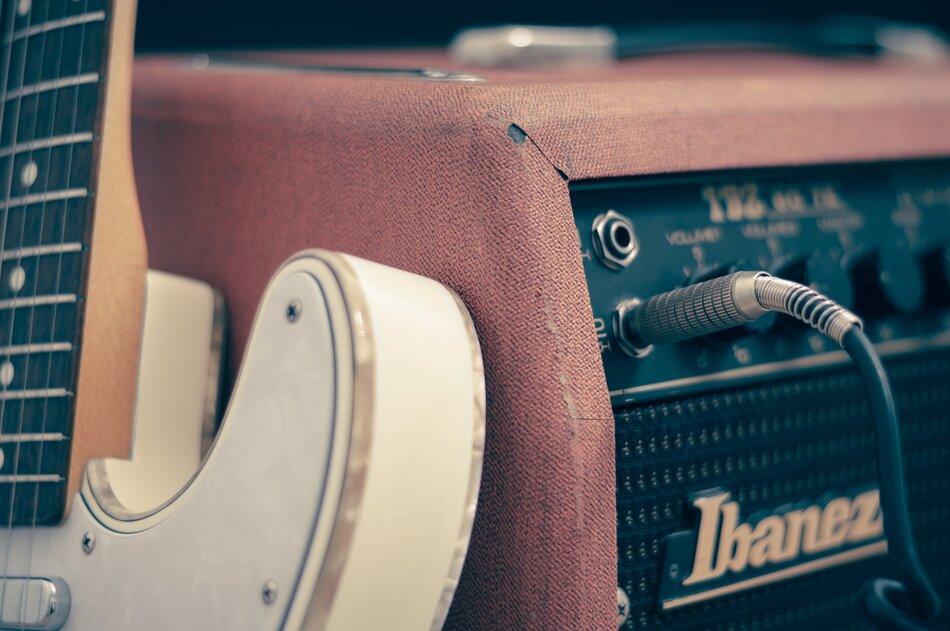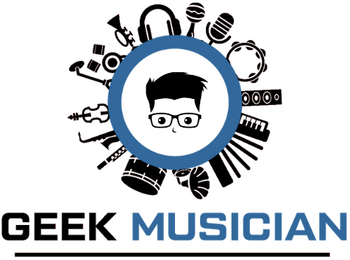
Guitar amps are an absolute necessity for every guitar player. It magnifies your guitar’s tone and brings out all the subtle artifacts of your guitar’s tone. But what if you want to record your guitar amp’s sound? Can you plug it directly into an audio interface?
You can plug a guitar amp into an audio interface. The best and simplest way is to connect the guitar amp’s line out port to the audio interface’s input using an audio cable, usually a 1/4 inch cable. The guitar amp’s audio signal will then be sent to the audio interface, where it can be recorded.
Table of Contents
Guitar amps are important for a couple of reasons.
The first duty of a guitar amp is to amplify the guitar’s sound. I think that’s a no brainer, and if you are an avid guitarist, you probably know this.
Electric guitars output a very low audio signal. You can barely hear an electric guitar that is not plugged into an amp; that’s because they output a very low audio signal. A guitar audio signal, without amplification, is known as an instrument-level signal.
When your guitar is plugged into an amp, it boosts the guitar’s audio signal from an instrument-level signal to a line-level signal.
Line level signal is a very strong signal that can be transmitted from one audio component to another. For instance, your amp’s line signal can be transmitted to your audio interface.
Now that we’ve covered the basics of guitar audio signal with or without an amp let me walk you through the right way to connect your amp to an audio interface. After that, we’ll discuss some important things you need to know to protect your amp as well as your audio interface. And then we’ll take a look at the recommended way to record your guitar amp. Let’s get into it.
How to Connect a Guitar Amp to an Audio Interface
Most guitar amps have a Line-Out. Line-outs allows you to transmit the audio generated from your amp into another audio device. The audio signal sent from the amp will be a line-level signal. As I explained earlier, these are strong audio signals that can be transmitted from one audio component to the other.
On your guitar amp, you will find a jack labeled a LINE OUT. Depending on your amp, it can either be an XLR male jack or a ¼ inch female jack.
To connect a guitar amp to an audio interface, plug one end of an audio cable into the LINE OUT of the amp and the other end into the LINE INPUT of the audio interface.
If both the Line Out and Line Input are ¼” jacks, then you have to use a ¼” balanced or unbalanced cable. However, if you own an amp head with an XLR male jack Line-Out, then you will need an adapter or a cable that will go from an XLR female to a TRS male jack connector. This cable on Amazon will get the job done.
It’s important to connect it to the Line Input on your audio interface. That’s because line inputs are designed to receive line-level signals. Line inputs are at unity gain, which means they neither amplify nor reduce the incoming audio signals’ dB level.
Can you plug the amp in a combo jack input?
Yes, but there is a right way to do it. Let me explain.
If you don’t know what it is, combo inputs are the inputs on our audio interface that accept both XLR mic input and ¼” TRS or TS input. These inputs are uniquely designed to receive Mic, Line, and Instrument Level signals. This means you can plug a microphone, a keyboard or synthesizer, an amp, or even your guitar directly into this input, and they will work.
But here is the catch.
Combo jack inputs have a preamp built into them. The preamp is useful when you plug in a microphone, a guitar, or bass directly into the audio interface. That’s because they boost the weak Mic and Instrument-level signal from these instruments into a line-level signal. By turning the gain of the combo input up, you increase the strength of the signal it is receiving.
However, the audio signal being transmitted by the guitar amp’s Line Out is already a Line-Level signal. This means there is no need to boost the signal with a preamp.
For this reason, it is advisable to turn the gain knob to zero if you are connecting your guitar amp to the audio interface through the combo jack input. This will help maintain the dB level sent from your amp and possibly protect the built-in preamp from damaging. So keep that in mind when you are using the combo jack input for an amp.
Important Things to Know.
Here is what to expect, as well as some vital tips you need to know to protect your amp and audio interface from damage.
1. Always connect a speaker cabinet to the amp head
Don’t’ consider using an audio interface as an alternative to a speaker cabinet. If you use an amp head, the speaker cabinet must still be connected if you want to use an audio interface. And this is for a good reason.
Running an amp head without connecting a speaker cabinet can result in damage to the amp.
Explaining the reason can get very technical, but I’ll try and make it as simple as possible.
Speaker cabinets are passive. For this reason, it has to be powered by the amplifier that it is connected to. For the amp to transfer maximum power to the speaker cabinets, the amp’s output impedance must match the speaker cabinets’ input impedance. However, that is not usually the case.
Different manufacturers make speakers with different input impedances depending on the size of the speaker.
In an effort to match the values of the two impedances, there is a transformer installed in the amp. What the transformer does is to either step up (increase) or step down (decrease) the speaker’s input impedance to match the output impedance of the amp, so that power can be transferred to the speaker.
However, when a speaker is not connected, the transformer assumes there is an infinite input impedance. The amp head will then draw more current in an effort to increase the amp’s output impedance to match the input impedance. And if you know anything about electronic devices, once they begin to draw high levels current, all the components will be destroyed in no time.
This is why you must always connect speakers to the amp even when you intend to use an audio interface. Very crucial.
2. Don’t Connect Speaker Output to Audio Interface
There is a significant difference between the signal sent through the Line-Out and signal sent through the Speaker Output.
The signal transmitted through an amp’s Line-Out is a line-level signal, which is an audible signal with an excellent dB level for further processing.
On the other hand, the signal transmitted through the speaker output on your amp is known as a speaker-level signal. Speaker level signals are amplified line-level signals. This means they are much louder and have higher voltages than line-level signals.
Speaker level signals are meant for large speakers such as cabinets and PA systems. So it’s a bad idea to send a speaker level signal to an audio interface. This can damage the audio interface’s preamps or the jack input it is connected to.
3. You won’t get the exact tone in the speakers
Something you should know is you won’t get the same tone as the one coming from your speaker cabinets when you connect the amp to the audio interface.
Speaker cabinets are a part of your guitar’s signal chain. Every cabinet has its own character and tone. That makes different cabinets sound different. Connecting your amp directly to the audio interface means you are bypassing the speaker.
This will make the tone of the signal you record in your DAW different from the one you are hearing from your guitar speakers.
However, this won’t be an issue for you if you have a good cabinet simulation plugin installed. There are quite a few guitar amp and cabinet simulator plugins out there to help you craft the best sounding guitar tone in your DAW. I recommend you look into them if you want to connect your guitar amp to your audio interface.
However, there is a better way to capture the guitar tone from your speaker cab, and here is how to do it.
Best Way to Record a Guitar Amp

This has been the traditional way to record a guitar amp for years. You’ll see this done in almost every professional studio or live sessions.
The best way to record a guitar amp is to capture the amp speakers’ sound with a microphone.
As I mentioned, this has been the go-to way to record your guitar from an amp because it gives you the best result.
Unlike recording the amp by connecting the line out to an audio interface, using a microphone to record the speaker cab captures the true character of the amp and the speakers. You’ll get the grittiness and crispiness of your guitar amp’s tone by recording the amp speakers with mic. Here is how to do it in a few steps
- Put microphone on a microphone stand
- Position the microphone in front of the speaker cabinet
- Plug the microphone into the audio interface
- Record
Shure SM 57 (Amazon) is undoubtedly the most popular microphone for recording guitar amps. It is one of the most transparent microphones you can find for capturing your guitar tone right from the amp speakers.
You can also experiment with different mic placements to get a different sound. For instance, you can place the mic directly in the middle of the speaker cabs, or place it a little to the left or at the corner of the cabinet. Different mic placements will alter the guitar tone recorded.
Summary
Yes, you can plug an amp in an audio interface, provided the amp has a line out. It is advisable to connect the line out to the line input on the audio interface. Also, keep the speaker cabinet connected if you are using an amp head.
The best way to record your guitar amp is by using a microphone to capture the amp speaker cabinet’s audio. That’s because connecting the guitar amp to an audio interface bypasses the speaker cabs, which is part of the guitar’s signal chain.

Hi, I’m Raymond. A keyboard player, music producer, and writer. And I’m also the founder of this blog. As someone who has been working with several audio and music equipment and different musicians for many years, my goal is to answer all your questions on music and equipment, as well as the latest music software and technology. For more info, check out my about me page
